Automotive Cooling system Myths
Don’t believe these 7 cooling system myths
Cooling system Myth #1
Removing the thermostat reduces overheating
If you think you can prevent engine overheating
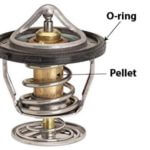
Engine Thermostat
by removing the thermostat, think again!
The thermostat serves two purposes;
• acts like a valve to regulate flow to keep the engine at a set temperature
• when fully open, the thermostat acts as a flow restrictor to prevent coolant from flowing too quickly through the radiator. When coolant flows too quickly through the radiator, it can’t offload the proper amount of heat.
When you remove the thermostat in your engine, you cause the coolant to flow through the radiator too fast and it comes out the bottom too hot! The water pump sucks in overheated coolant and recirculates it through your engine where it picks up even more heat. Removing the thermostat causes the engine to overheat FASTER.
Cooling system Myth #2
Water is the best coolant
Water does provide the best heat conduction; it’s much better than coolant. BUT, water is the WORST coolant for your engine. Water contains no corrosion inhibitors or water pump lubricants. With all the different metals in an engine and cooling system, running water as a coolant is a great way to enable electrolysis that eats away at the radiator, heater core, water pump impeller and housing and metal heater tubes.
Running water as a coolant will result in major repair costs down the line. You should never run water in your engine’s cooling system for any long period of time.
Cooling system Myth #3
“Freeze plugs” are designed to protect your engine from freezing damage
First, the term “freeze plugs” is incorrect. 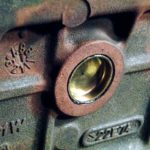 They are actually called “core plugs” and they exist for ONLY ONE REASON. Core plugs are used to plug holes in the engine that are specifically created so the engine builder can remove casting sand. Once the casting sand is washed out, the engine builder install core plugs to seal the cooling system.
They are actually called “core plugs” and they exist for ONLY ONE REASON. Core plugs are used to plug holes in the engine that are specifically created so the engine builder can remove casting sand. Once the casting sand is washed out, the engine builder install core plugs to seal the cooling system.
If your coolant is too weak to withstand freezing, the engine block will likely crack long before the core plugs pop out. I’ve seen dozens of cracked blocks with the core plugs still in place. NEVER rely on a core plug to prevent engine freezing.
Cooling system Myth #4
Change out the fan blade to get better cooling
Moving air too quickly across the radiator fins can actually result in LESS cooling. Just like coolant that moves too quickly through the radiator, finding the right airflow speed is critical to maximum heat removal. Engineers aren’t stupid, they match the fan blade and fan motor speed to the radiator size and engine.
Cooling system Myth #5
Fan shrouds don’t actually have anything to do with cooling, they’re there to prevent people from sticking their fingers in the fan.
WRONG!
Fan shrouds have a direct impact on airflow 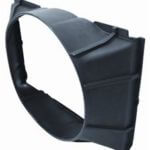 velocity through the radiator. Leave it off and you’ll reduce airflow and actually CAUSE overheating.
velocity through the radiator. Leave it off and you’ll reduce airflow and actually CAUSE overheating.
Cooling system Myth #6
Always replace factory “constant tension” hose clamps with new worm drive clamps.
WRONG!
As car makers started using more and 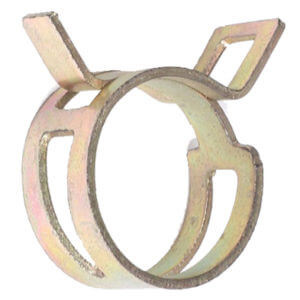 more plastic components in their cooling systems they ran into issues with cracked radiator necks and thermostat housings. The cracking problem is caused when the plastic components expand and contract a different rate than the stainless steel worm drive clamps. So car makers switched to constant tension spring-like clamps and heat shrinkable hose clamps.
more plastic components in their cooling systems they ran into issues with cracked radiator necks and thermostat housings. The cracking problem is caused when the plastic components expand and contract a different rate than the stainless steel worm drive clamps. So car makers switched to constant tension spring-like clamps and heat shrinkable hose clamps.
Replacing a constant tension or heat shrinkable clamp with a worm drive clamp can actually crack your radiator or thermostat housing. Don’t use old technology clamps on newer cars unless you’re willing to pay the price of damaged cooling system components.
Cooling system Myth #7
Serpentine drive belts must be replaced when the ribs develop cracks.
Wrong.
Older vehicles used nitrile serpentine belts.
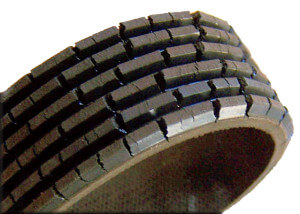
This one is toast. It has too many cracks in a a three inch section.
As nitrile ages, it cracks. But cracks alone don’t mean the belt must be replaced. It’s the number of cracks in a 3” section. To assess the condition of a nitrile multi-rib belt, simply count the number of cracks in a single rib in a 3” section. Three or more cracks means the belt has gone beyond the 80% mark and it’s time to replace it. Nitrile belts wear out as quickly as 30M miles
For longer life, replace nitrile serpentine drive belts with newer EPDM belts. They last almost 100,000 miles.
©, 2018 Rick Muscoplat
Posted on by Rick Muscoplat